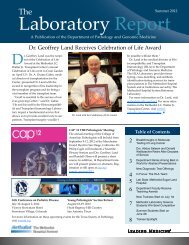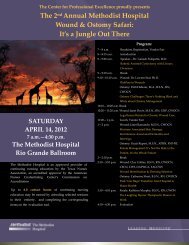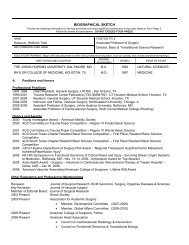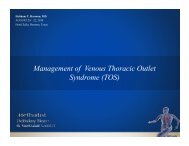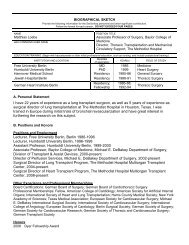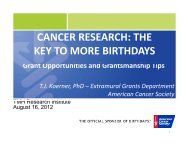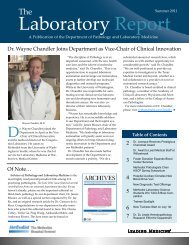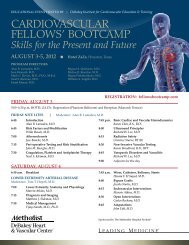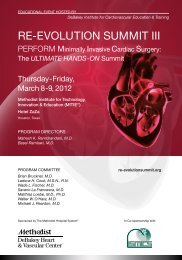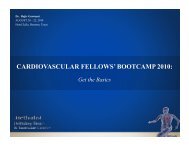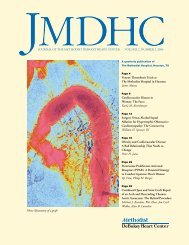DeBAKEy CARDIOvASCuLAR JOuRNAL - Methodist Hospital
DeBAKEy CARDIOvASCuLAR JOuRNAL - Methodist Hospital
DeBAKEy CARDIOvASCuLAR JOuRNAL - Methodist Hospital
You also want an ePaper? Increase the reach of your titles
YUMPU automatically turns print PDFs into web optimized ePapers that Google loves.
M.E. Bertrand, M.D.<br />
Introduction<br />
WHAT ARE THE CuRRENT RISKS OF<br />
CARDIAC CATHETERIZATION?<br />
Michel E. Bertrand, M.D.<br />
Lille Heart Institute, Lille, France<br />
Since the first heart catheterization performed by Werner Forssmann on himself in 1929, this technique<br />
has undergone an extraordinary expansion and widespread application. Today, several million heart catheterizations<br />
are performed throughout the world each year. Heart catheterization is not only a fantastic<br />
investigative tool that provides precise information regarding anatomy and physiology, but it also offers<br />
a number of important and very effective interventions. Forssmann imagined heart catheterization as a<br />
delivery mechanism for drugs to enhance their efficacy, and heart catheterization has indeed become, in<br />
a large number of cases, a therapeutic tool.<br />
Cardiac catheterizations are performed in a large number of centers worldwide, and the complication rate<br />
is low. Nevertheless, zero risk does not exist in medicine. This analysis focuses on the procedural risks<br />
of cardiac catheterization and coronary angiography but does not discuss the risks related to specific<br />
interventions (e.g., the risks of stent implantation, atherectomy, or systemic anaphylactoid reactions to<br />
iodinated contrast media). Actually, vital risks of heart catheterization are very rare, and most complications<br />
are related to the access site.<br />
Recent Data Concerning the Risks of<br />
Procedure-Related Complications<br />
Many publications and books about complications<br />
during and after cardiac catheterization refer to the<br />
publication of a 1991 report prepared by Noto for the<br />
Society for Cardiac Angiography and Interventions. 1<br />
Ten years later, a single-center report, summarized in<br />
Table 1, was published by the Montreal Heart Institute. 2<br />
The report is a prospective analysis collected over a<br />
2-year period (April 1996 to March 1998) of 11,821<br />
procedures and includes in-hospital and one-month<br />
follow-up of 7,953 diagnostic and 3,868 therapeutic<br />
procedures.<br />
More recent data can be obtained from the ALKK<br />
registry (Arbeitsgemeinshaft Leitende Kardiologische<br />
Krakenhausärzte) initiated in 1992 in Germany. The<br />
last report, published in 2005, 3 covers the year 2003 and<br />
89,064 procedures performed in 75 German centers,<br />
including 58,935 invasive procedures, 23,867 invasive<br />
Complication Diagnostic Therapeutic Total<br />
n=7,953 n=3,868 n=11,821<br />
Death 34 (0.4%) 42 (1.1%) 76 (0.6%)<br />
Procedure-<br />
related death<br />
8 (0.1%) 21 (0.5%) 29 (0.2%)<br />
Q-wave MI 3 (0.04%) 24 (0.6%) 27 (0.2%)<br />
Non-Q-wave MI 5 (0.06%) 133 (3.4%) 138 (1.2%)<br />
Emergency<br />
CABG<br />
Pulmonary<br />
edema<br />
4 (0.05%) 13 (0.3%) 17 (0.1%)<br />
11 (0.1%) 21 (0.5%) 32 (0.3%)<br />
Table 1. Incidence of cardiac complications from a single center<br />
reporting 11,821 procedures (April 1996-March 1998). 2<br />
MDCvJ | vII (1) 2011 35



